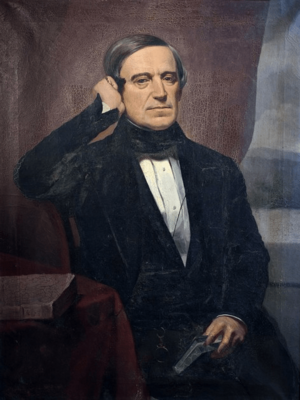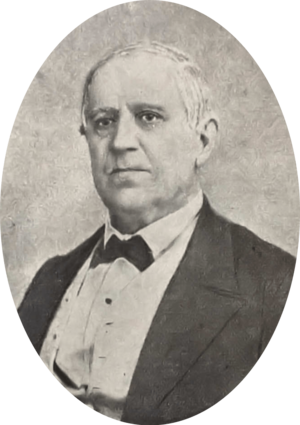António Luís de Seabra, 1st Viscount of Seabra facts for kids
Quick facts for kids
His Lordship
The Viscount of Seabra
|
|
|---|---|
 |
|
| Minister and Secretary of State of Ecclesiastical Affairs and Justice |
|
| In office 4 January 1868 – 22 July 1868 |
|
| Monarch | Luís I of Portugal |
| Preceded by | Augusto César Barjona de Freitas |
| Succeeded by | António Pequito Seixas de Andrade |
| In office 4 March 1852 – 19 August 1852 |
|
| Monarch | Maria II of Portugal |
| Preceded by | Joaquim Filipe de Soure |
| Succeeded by | Frederico Guilherme da Silva Pereira |
| Personal details | |
| Born | 2 December 1798 Atlantic Ocean |
| Died | 19 January 1895 (aged 96) Mogofores, Anadia, Portugal |
| Nationality | Portuguese |
| Occupation | Politician |
D. António Luís de Seabra e Sousa, 1st Viscount of Seabra (born December 2, 1798 – died January 19, 1895) was an important Portuguese politician, lawyer, and judge. He lived during the time of the Constitutional Monarchy in Portugal.
He held many important jobs. He was a government minister, the head (called a rector) of the University of Coimbra, and a judge. He also served in Parliament, which is like a country's law-making body.
The Viscount of Seabra is most famous for writing Portugal's first Portuguese Civil Code in 1867. This set of laws for everyday life was used for a whole century! People sometimes still call it the "Seabra Civil Code."
Contents
Biography
Early Life and Education
António Luís de Seabra was born on December 2, 1798. He was born on a ship called Santa Cruz near Cape Verde. His parents were traveling to Rio de Janeiro because his father had a new job there.
He was baptized in Rio de Janeiro in 1799. Later, he returned to Portugal for school. In 1815, he started studying Law at the University of Coimbra. He finished his degree in 1820.
Political Beginnings
During his student years, António Luís de Seabra supported the "Constitutionalists." These were people who wanted a government based on a constitution, not just a king's rule. When he heard about the Liberal Revolution of 1820 in Oporto, he wrote a poem that became very popular. He also started a political and literary magazine called O Cidadão Literato.
In 1821, he became a judge in Alfândega da Fé. He was even praised by the Minister of Justice for his good work.
Challenges and Return
In 1823, the liberal government fell. Seabra resigned from his job and went to his family's home. There, he spent his time translating old Roman writings and studying.
In 1825, he became a judge in Montemor-o-Velho. He also published some of his own writings.
When King Miguel took the throne in 1828, Seabra disagreed with him. He had to leave Portugal and lived abroad for a while. He wrote about the political problems in his home country.
He returned to Portugal in 1833 after the Constitutionalists won the Portuguese Civil War. Soon after, he became a prosecutor and was elected to Parliament in 1834.
Career in Politics and Law
In 1836, he started another political magazine called O Independente. He was elected to Parliament again that same year. He continued to be an active member of Parliament, representing different areas.
In 1849 and 1850, he published important works about law and property. These writings showed his deep understanding of legal matters.
The Civil Code
In 1850, António Luís de Seabra was given a very important task. He was asked to create a new civil code for Portugal. This code would bring together all the private laws of the kingdom.
He finished the project in 1859. The civil code was discussed in Parliament for a long time. Finally, it was approved on July 1, 1867. This set of laws, often called Seabra's Civil Code, was used for exactly 100 years! It was replaced in 1967.
Later Career
In 1851, he was elected to Parliament again. In 1852, he became the Minister of Ecclesiastical Affairs and Justice. This meant he was in charge of church matters and justice for the country.
In 1862, he became the Speaker of the Chamber of Deputies. This is a very important role in Parliament. In 1868, he became a Peer and then Speaker of the Chamber of Most Worthy Peers.
From 1866 to 1868, he was the Rector (head) of the University of Coimbra. After that, he became Minister of Ecclesiastical Affairs and Justice again.
In his later years, his eyesight became very poor. But he still worked hard, even translating more old texts. His last published work was in 1893. He also left a novel unfinished.
Private Life
The Viscount of Seabra was married twice. His first wife was his cousin, Doroteia Honorata. They had three sons: António Luís, Álvaro Ernesto, and Francisco Luís. Francisco later became a priest.
His second wife was Ana de Jesus Teixeira. She already had children from her first marriage. With Ana, the Viscount of Seabra had one son named Aristides.


